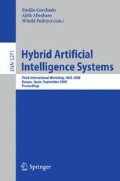Abstract
We have already proposed multiobjective genetic fuzzy rule selection with a multi-classifier coding scheme for the design of ensemble classifiers. An entropy-based diversity measure was used as an objective to be maximized for increasing the diversity of base classifiers in an ensemble. In this paper, we examine the use of other diversity measures in the design of ensemble classifiers. Experimental results show that the choice of a diversity measure has a large effect on the performance of designed ensemble classifiers.
Access this chapter
Tax calculation will be finalised at checkout
Purchases are for personal use only
Preview
Unable to display preview. Download preview PDF.
References
Breiman, L.: Bagging Predictors. Machine Learning 24, 123–140 (1996)
Freund, Y., Schapire, R.E.: A Decision-theoretic Generalization of On-line Learning and an Application to Boosting. Journal of Computer and System Sciences 55, 119–139 (1997)
Kuncheva, L.I., Whitaker, C.J.: Measures of Diversity in Classifier Ensembles and Their Relationship with the Ensemble Accuracy. Machine Learning 51, 181–207 (2003)
Tang, E.K., Suganthan, P.N., Yao, X.: An Analysis of Diversity Measures. Machine Learning 65, 247–271 (2006)
Abbass, H.A.: Pareto Neuro-evolution: Constructing Ensemble of Neural Networks using Multi-objective Optimization. In: Proc. of 2003 IEEE Congress on Evolutionary Computation, pp. 2074–2080 (2003)
Jin, Y., Okabe, T., Sendhoff, B.: Evolutionary Multi-objective Optimization Approach to Constructing Neural Network Ensembles for Regression. In: Coello, C.A.C., Lamont, G.B. (eds.) Applications of Multi-Objective Evolutionary Algorithms, pp. 653–673. World Scientific, Singapore (2004)
Chandra, A., Yao, X.: DIVACE: Diverse and Accurate Ensemble Learning Algorithm. In: Yang, Z.R., Yin, H., Everson, R.M. (eds.) IDEAL 2004. LNCS, vol. 3177, pp. 619–625. Springer, Heidelberg (2004)
Nojima, Y., Ishibuchi, H.: Designing Fuzzy Ensemble Classifiers by Evolutionary Multiobjective Optimization with an Entropy-based Diversity Criterion. In: Proc. of 6th International Conference on Hybrid Intelligent Systems and 4th Conference on Neuro-Computing and Evolving Intelligence CD-ROM (4 pages) (2006)
Nojima, Y., Ishibuchi, H.: Genetic Rule Selection with a Multi-Classifier Coding Scheme for Ensemble Classifier Design. International Journal of Hybrid Intelligent Systems 4(3), 157–169 (2007)
Ishibuchi, H., Nozaki, K., Yamamoto, N., Tanaka, H.: Selecting Fuzzy If-then Rules for Classification Problems using Genetic Algorithms. IEEE Trans. on Fuzzy Systems 3, 260–270 (1995)
Ishibuchi, H., Murata, T., Turksen, I.B.: Single-objective and Two-objective Genetic Algorithms for Selecting Linguistic Rules for Pattern Classification Problems. Fuzzy Sets and Systems 89, 135–150 (1997)
Ishibuchi, H., Nakashima, T., Murata, T.: Three-objective Genetics-based Machine Learning for Linguistic Rule Extraction. Information Sciences 136, 109–133 (2001)
Ishibuchi, H., Nakashima, T., Nii, M.: Classification and Modeling with Linguistic Information Granules: Advanced Approaches to Linguistic Data Mining. Springer, Berlin (2004)
Ishibuchi, H., Yamamoto, T.: Comparison of Heuristic Criteria for Fuzzy Rule Selection in Classification Problems. Fuzzy Optimization and Decision Making 3, 119–139 (2004)
Deb, K., Pratap, A., Agarwal, S., Meyarivan, T.: A Fast and Elitist Multiobjective Genetic Algorithm: NSGA-II. IEEE Trans. on Evolutionary Computation 6, 182–197 (2002)
Author information
Authors and Affiliations
Editor information
Editors and Affiliations
Rights and permissions
Copyright information
© 2008 Springer-Verlag Berlin Heidelberg
About this paper
Cite this paper
Nojima, Y., Ishibuchi, H. (2008). Effects of Diversity Measures on the Design of Ensemble Classifiers by Multiobjective Genetic Fuzzy Rule Selection with a Multi-classifier Coding Scheme. In: Corchado, E., Abraham, A., Pedrycz, W. (eds) Hybrid Artificial Intelligence Systems. HAIS 2008. Lecture Notes in Computer Science(), vol 5271. Springer, Berlin, Heidelberg. https://doi.org/10.1007/978-3-540-87656-4_93
Download citation
DOI: https://doi.org/10.1007/978-3-540-87656-4_93
Publisher Name: Springer, Berlin, Heidelberg
Print ISBN: 978-3-540-87655-7
Online ISBN: 978-3-540-87656-4
eBook Packages: Computer ScienceComputer Science (R0)

